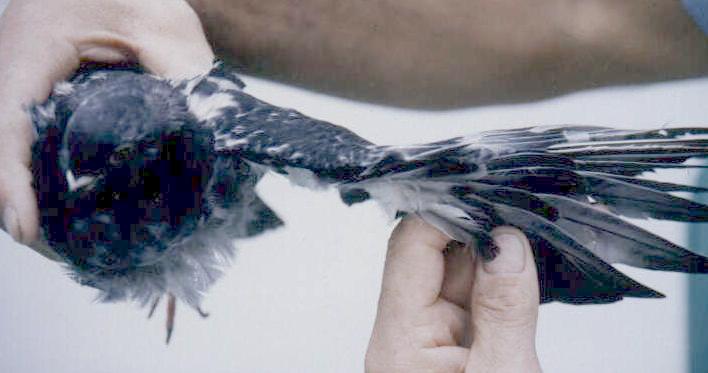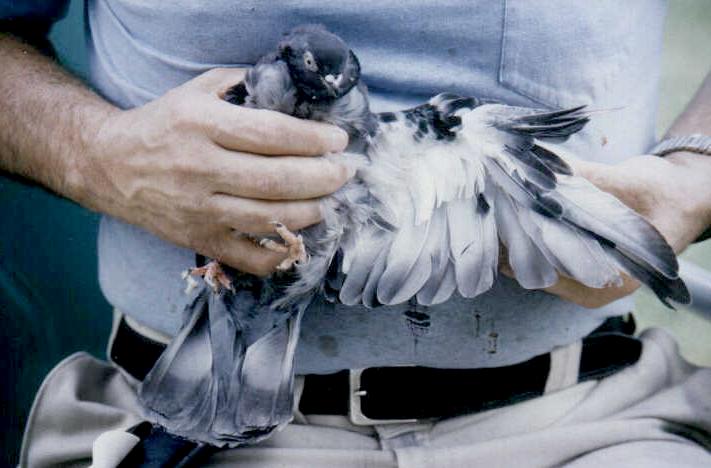pigeons
"Mirror Imaged" Multiple Flights
By Robert J. Mangile
American Pigeon
Journal
April 1992, pages 34 & 56.
At the October 1987, National Young Bird Show in Louisville, Kentucky, Arwyn Taugner of St. Croix, Minnesota gave me a blue T-pattern Checker Chinese Owl hen (IPB-86-495-BE) that displayed a very interesting wing abnormality (Photo 1). Beneath her left wing were ten additional flights and complimentary coverts growing directly opposite the ten normal flights, but they were upside down. To be a bit more specific, the ten extra flights were a "mirror image" of the ten normal flights with the feather surfaces closing against the body and their undersides facing the undersides of the normal flights. By holding your hands together like a clamshell, as in prayer, the characteristic may be more easily envisioned.

Photo No. 1
Taugner's Blue T-pattern Checker, Chinese Owl hen (IPB-86-495-BE) displaying ten extra "mirror imaged" (inverted) flights on the left wing. Photo by Ron Mangile. Mated to a Brander Bronze Show Tippler male, nine (9) offspring of both sexes were produced by June of 1988, all with normal wings.
The first male offspring to mature was back-crossed to Taugner's hen. Of eleven (11) offspring, eight (8) had at least one wing containing only nine flights. Of the nine flighted progeny, two hens displayed malpositioned feathers in their left wing. One (1082-C) had several flights and some coverts upside down at the tip of the somewhat shortened, left wing (Photo No. 2), and the other had a small clump of extra feathers on the upper surface of the left wing at the joint, between the fifth and sixth primaries. It seems pertinent that only the left wing of females were involved.

Photo No. 2
Blue T-pattern checker Tippler back-cross hen (1082-C). Primaries 1 through 4 are normal, then a gap and two twisted primaries (note webbing/shaft relationship); then a group of smaller twisted feathers that may or may not be degenerate of primaries. The allula is present despite shortened appearance of the wing. The right wing has nine flights. Photo by Ron Mangile.
Not satisfied with the results, the original hen was paired to a black Racing Homer male and they produced four normal offspring of both sexes. And later she was paired to a Chalky Racing Homer male and produced two more normal offspring.
Paired to a son from the black Homer male, three more normal offspring were produced. Paired to a son from the Chalky male, five offspring were produced all normal except one that had a slightly splayed right wing when fledged.
Only normal winged offspring were produced from other pairing combinations which include... brother X sister; half brother X half sister; other closely related birds; and F1's out-crossed to Racing Homers. Only in the back-cross from the Show Tippler cock was any abnormal wing condition produced that appeared similar to the condition displayed in Taugner's Chinese Owl hen. The infusion of the Show Tippler's genome may have been more conducive to its production its than that of Racing Homers.
Only tentative conclusions can be drawn this time. The total of seventeen (17) normal offspring produced from Taugner's hen, when paired to three different males, indicates recessiveness for this abnormal wing condition. The two abnormally winged, as in the Tippler back-cross, further suggests recessiveness. The nine flighted condition may or may not be considered to be an expression of the abnormal wing condition?
Though my limited breeding data indicates a recessive nature, more breeding data is necessary for a better understanding of this trait. Similar abnormalities have been observed by other fanciers. I've listed a few blow:
- At a swap meet, several years ago, Mike Tuma of Oklahoma displayed a Flying Tumbler squeaker with a stump wing.
- In 1991, Guy Marlar of Oklahoma, raised a Lahore X Ice Pigeon hybrid with a stump wing.
-In PGNV&C (Issue #35, page 4), Biran Doige of Alberta, Canada, writes that in 1990 he raised an offspring from a brother X sister mating of mongrels (1/2 Chinese Owl, Ice Pigeon and Damascene) with three extra, upside down, flights on the leading edge of the left wing; along with other extra smaller feathers on both wings.
- Arwyn Taugner also raised other birds with varying wing abnormalities; including a stump winged bird, and he assumed their cause was hereditary.
- Lester "Paul" Gibson of Ohio has a line of birds with similar conditions, including stump winged specimens. Taugner forwarded stock to Gibson for breeding tests and comparison.
Whether this "mirror imaging" of wing feathers is unique or only one expression in a wide range of expressions which include the stump wing condition, is not known at this time. If you know of any similar birds, reporting them would surely be of interest to some fanciers.